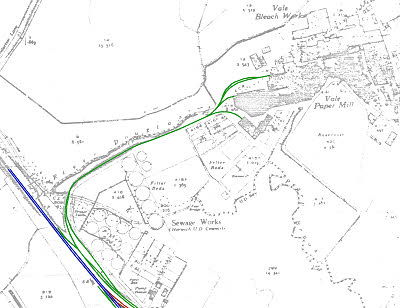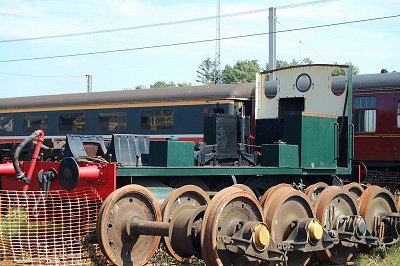Industry - The Cooke & Nuttall Vale Paper Mill
 Leonard Cooke began the manufacture of paper on the site of the Vale Mills in 1862, and, after his death, the business was carried on by his son, Horace Cooke. In 1898, Mr T.Y.Nuttall joined the firm and the mills were completely rebuilt and equipped with new machinery. Cooke & Nuttall Ltd were the first manufacturers in Great Britain to produce 'Kraft' paper.
Leonard Cooke began the manufacture of paper on the site of the Vale Mills in 1862, and, after his death, the business was carried on by his son, Horace Cooke. In 1898, Mr T.Y.Nuttall joined the firm and the mills were completely rebuilt and equipped with new machinery. Cooke & Nuttall Ltd were the first manufacturers in Great Britain to produce 'Kraft' paper.
The paper mill wasn't rail-served until some time after 1900, but the 1939 OS map (opposite) clearly shows the network of lines which developed during that period. According to George Harding, Station Master during the 1940s and 50s, the holding sidings to the north-east of the station had become insufficient, and the former coal sidings were also used for pulp trains. See the Maps & Info page for more information.
Chris Baines, Signalman at Horwich Fork Jn in the late 1960s, recalls :
"Cook and Nutalls wood pulp trains - these came on a trip working from Ribble (Preston Dock). After the loco had put the loaded wagons in the siding it would drop down light engine into the platform at Blackrod and take notices and water to Horwich Fork Junction,Hilton House,and Blackrod Branch Junction Signal boxes before returning and then go onto the empty pulp wagons at the top end before returning to Ribble."
Thanks to Chris Baines for this information
The steeply-graded line from the Vale Paper Mill, rose to the level of the main line just to the north-west of the signal box. Two lines then ran parallel with the main line and into a head-shunt along side the Horwich Branch platform. Access to the main line was via the branch or a north-facing link on the main line. The C&N's own locos tripped loads and empty wagons down and up the exchange sidings, where they would have been dropped or collected by a main-line locomotive. The C&N LocosWhen the Cooke & Nuttall rail system opened, the works loco was an ex LMS (formerly L&YR) "Pug" 0-4-0 saddle-tank. Many such locos found their way into industrial use, being ideal for the tight curves which were common in such places. C&N's "Pug" no.11249 was bought from the LMS on 28th March 1936 after withdrawal from Arbroath, but was quickly found to be in poor condition. It therefore spent a period in Horwich Locomotive Works, where it received a full re-tubing and overhaul - the last "Pug" to do so at Horwich? 11249 retained LMS livery for its 11-year spell at the Vale Paper Mill and was scrapped upon the arrival of it's replacement. From 1947 the works shunter at the Vale Paper Mill was an 0-4-0 Barclay saddle tank, Numbered No 1 and named "Douglas" By Cooke & Nuttalls, the loco was built by Andrew Barclay of Kilmarnock (works no 2230) like the "Pug" it replaced, was the only locomotive in use on the C&N site. |
 Douglas makes a rare trip up to the station. C&N Barclay shunter is pictured in the headshunt opposite the branch platform. Photo : Alan Castle Douglas makes a rare trip up to the station. C&N Barclay shunter is pictured in the headshunt opposite the branch platform. Photo : Alan Castle |
|
 Douglas in bright sunlight outside the
C&N works. Douglas in bright sunlight outside the
C&N works.Photo : Stan Withers |
||
 Photo : J.A.Sommerfield Courtesy of Martin Bott www.bottbooks.com |
||
On 12th March 1966, an LCGB (North West Branch) tour visited the Cooke & Nuttall system, where participants were treated to a series of trips up and down the branch, and into the headshunt adjascent to the Horwich Branch platform. These are three of a seres of six photos depicting the procedings, kindly supplied by Charlie Verrall. The full set of photos are available in our Photo Archive... Or, along with many other fascinating photos, at Charlie's Flickr Photostream |
||
 Photo : C.Verrall |
 Photo : C.Verrall |
|
When the M61 motorway came to the area in 1967 / 68, it was to be driven right through the Cooke & Nuttall branch, but an underpass for the line was provided, so that traffic could recommence after a short hiatus. In the event, rail traffic never did return and the bridge was never used as intended. The paper mill had already been in decline for a number of years, and the writing was perhaps already on the wall. Traffic which had moved to road transport during the motorway construction, remained so for the few years which remained before the paper mill closed. It appears that the line itself was actually reinstated under the motorway and Douglas is said to have spent some time there, with the bridge acting as a rather large and expensive engine shed! |
||
 Douglas at the 2008 Carnforth Open Day Photo : Adrian Bradshaw |
||
Happily, Douglas was preserved at Steamtown Carnforth and after restoration, could be seen running up and down the Carnforth lines carrying Steamtown visitors during the 1980s (see photo below). Whilst in service there, the loco appears to have gained a new name "Hurricane", but did carry "Cooke & Nuttall" lettering on the tank, in a similar style to that which it carried in its working life.
After the closure of Steamtown, the loco remained at the site which is now operated commercially by West Coast Railways Co. as a base for their fleet of main-line "vintage" diesels and for a stable of main line steam locos. These locos are also overhauled and maintained at the site and "Douglas" is now owned by one of the WCRC employees. "Douglas" is currently dismantled, but the intention is to restore the loco as time permits.
At the 2008 Carnforth Open Day, the chassis of a Barclay 0-4-0, said to be 2230 "Douglas", were in out in the open. The third opening in the rear of the cab is unusual in Barclays, though not unique.

